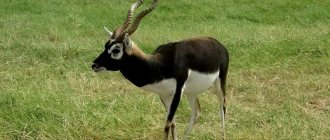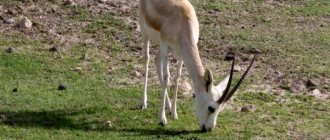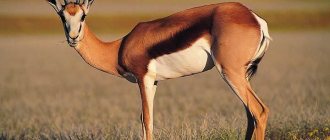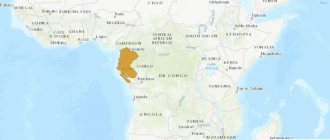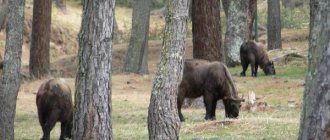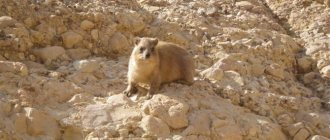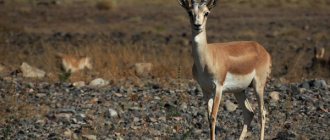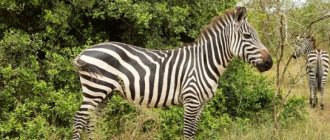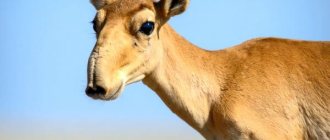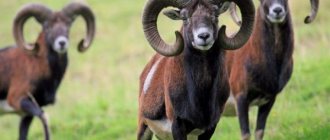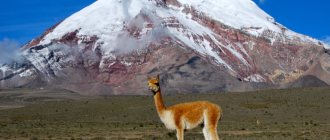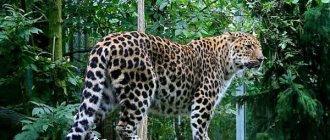Appearance of pronghorn
Pronghorns have a beautiful appearance, they have an elegant and slender body, its length from nose to tail ranges from 1.3-1.5 meters.
Males weigh on average 40-65 kilograms, and the weight of females varies from 35 to 50 kilograms. The height at the withers is approximately 80-104 centimeters.
Both males and females have horns. Males have longer and thicker horns, ending in branched forks. In females they are much thinner and shorter, and there are no branches. Animals change their horns every year after the mating period. This process lasts about 4 months. In males, the average length of the horns reaches 25 centimeters, and in females only 12 centimeters, but sometimes they can be tiny, almost invisible. The horns are compressed from the side and resemble blades in shape.
The upper part of the body is light brown in color. The fur on the belly, chest and back is white. Males have a black stripe on the throat followed by white stripes. The muzzle is black and white.
The eyes are set high. There are no infraorbital pits. Pronghorns have certain anatomical features that allow them to develop great speed. They can run for 6 kilometers at a speed of 60 kilometers per hour, but are capable of accelerating up to 90 kilometers per hour, although at this speed they run short distances not exceeding 1 kilometer.
Reproduction
Pronghorns are polygamous animals. The rutting period begins at the end of summer and lasts about 2 weeks. During this period, fierce fights occur between males. Males collect a harem of 3-4 females, sometimes 8-15. Pronghorn pregnancy lasts from 230 to 240 days, and 60% of females give birth to twins. A newborn calf weighs 2.3-3.2 kg and is gray in color. In the first days he lies hidden in the grass, but after a week he runs well, after 3 weeks he begins to eat grass, and at the age of 3 months he is almost indistinguishable from an adult animal. The lifespan of pronghorns in nature is 5-7, sometimes up to 10 years.
Related species
The saiga
pronghorn is the only American antelope. There is no clear definition in the taxonomy of this animal: some scientists classify it as a member of the bovid family, along with species of African and Asian antelopes; according to others, the pronghorn belongs to the deer family. However, since the pronghorn has both traits of both families, as well as a number of individual ones, it is increasingly classified as a single species of the pronghorn family. However, there is no doubt that the pronghorn is distantly related to antelopes.
- 32 facts about tigers
- Weasel
- Whale shark
- 34 facts about raccoons
- Maned wolf
- Nettle
Bushbuck (Tragelaphus scriptus) lives in the vast savannas of Africa; not found only in the Sahara and the deserts of the southern part of the continent. Leads a solitary lifestyle in forests and bush-overgrown bushes.
The saiga antelope (Saiga tatarica) inhabits a limited range in Central Asia. An indigenous inhabitant of the dry steppes, where he roams in huge herds in search of fresh pastures.
COMMUNICATION THROUGH SMELL AND “MIRROR”
In case of danger, pronghorns communicate with each other using a unique communication system: they ruffle their long hair, which becomes like a chrysanthemum, white hair approximately 7-10 cm long grows on the sides of the root of the tail so that two “mirrors” appear in the shape sockets that reflect light and are visible for kilometers. Relatives nearby immediately transmit this alarm signal further. To enhance the signal, scent glands under the animals' tails emit a pungent odor. Other scent glands are located under the eyes, above the end of the sacrum bone, on the outside of the heel and between the toes.
Habitat
Herds of pronghorn stay in areas with varied vegetation cover, preferring areas with grass no higher than 40 cm.
The pronghorn inhabits the prairies of western North America, where it is found at altitudes up to 3000 m. Its range extends from Southern Canada through the Midwestern United States to the northern states of Mexico. The pronghorn’s favorite habitat is endless steppes with slightly hilly terrain and vegetation cover typical of prairies. Part of the population has chosen areas overgrown with bushes. Pronghorns live in a fairly dry climate where annual precipitation is insufficient for tree growth.
Behavior
The timing, length and structure of seasonal migrations vary depending on the region. In general, pronghorn form large winter herds that break up in the spring. In summer, the herd size averages 12 individuals. Pronghorns are able to travel up to 160 km from their wintering grounds to avoid very deep snow cover.
Natural barriers such as rivers and mountain ranges limit movement and contribute to the discontinuous nature of the range. Man-made barriers such as fences, highways and railroads now also have a significant impact on migratory routes, preventing pronghorn from reaching needed grazing areas.
In sedentary populations, males occupy individual areas of 0.2–4.3 km² in early May and guard them until the end of the rutting period, although mating occurs only in the fall. Groups of bachelors graze in territories with an area of 5.1–12.9 km², but their pastures are not as abundant in food as those of territorial solitaries.
Communication with each other is carried out through visual, vocal and olfactory signals. Males have 9 glands (2 under the ears, 2 on the rump on the sides of the tail, 1 above the tail and 4 between the hooves) that secrete an odorous secretion, while females have 6 (4 between the hooves and 2 on the rump). The tail glands secrete in times of danger, and animals use the secretion of the ear glands to mark territory and during courtship.
Pronghorns are herbivores. The basis of their diet consists of stems, leaves, grasses and shrubs. Young shoots play a very important role, especially wormwood in the winter. Subshrubs with high water content are preferred in summer. The need for watering depends on the water content of the vegetation: for example, with a large number of young leaves, with a 75% moisture content, pronghorns do not need to directly drink water, while during dry periods of the year or in dry regions they drink up to 3 liters of water in a day.
Pronghorns must compete for habitat with introduced cattle and sheep. In some areas, pronghorns have disappeared altogether because introduced animals have eliminated much of their preferred vegetation.
Young or weak individuals become prey to coyotes ( Canis latrans
), bobcats (
Lynx rufus
), pumas (
Puma concolor
), wolves (
Canis lupus
) and golden eagles (
Aquila chrysaetos
). To protect themselves from predators, pronghorns use horns and fast running. Being curious, they will move towards a creature that interests them until they identify it; if the creature turns out to be a predator, the pronghorn will take flight. Keen vision helps pronghorns spot a predator from a distance of two kilometers.
Recommendations
- Grubb, P. (2005). "Order of artiodactyls." In Wilson, D.; Reeder, D.M. (ed.). Mammal Species of the World: A Taxonomic and Geographical Guide
(3rd ed.). Johns Hopkins University Press. pp. 671–2. ISBN 978-0-8018-8221-0. OCLC 62265494. - ^ a b c d f g
IUCN Antelope Specialist Group (2016).
" Antilocapra americana
(revised version published 2022)."
IUCN Red List of Threatened Species
.
2016
: e.T1677A115056938. Retrieved August 31, 2022. - Wells, John S. (2008), The Longman Pronunciation Dictionary
(3rd ed.), Longman, ISBN 9781405881180 - Cato, J. D. (1876). "American Antelope, or Prong Buck." American naturalist
.
10
(4): 193–205. Doi:10.1086/271628. JSTOR 2448724. - Farb, Peter (1970). Ecology
. Books of life time. pp. 126, 136 - ^ a b c d e
Howes, Alex (November 2001).
"Pronghorns are survivors of the American savannah." Zoogoer
. Smithsonian Institution. Archived from the original on 2009-07-13. Retrieved 2015-11-21. - ^ a b c d
Smithsonian Institution.
Mammals of North America: Pronghorn Antilocapra americana - " Capromeryx furcifer
Matthew 1902."
Paleobiology Database
. Retrieved 2015-11-21. - " Capromeryx minor
Taylor 1911."
Paleobiology Database
. Retrieved 2015-11-21. - " Stockoceros conklingi
Stock 1930."
Paleobiology Database
. Retrieved 2015-11-21. - " Stockoceros onusrosagris
Roosevelt and Burden 1934."
Paleobiology Database
. Retrieved 2015-11-23. - " Tetramerix Shuleri
Calm 1921."
Paleobiology Database
. Retrieved 2015-11-21. - Upham, N.S.; Esselstyn, J.A.; Jetz, W. (2019). "Mammal tree inference: sets of species-level phylogenies for questions of ecology, evolution, and conservation." PLOS Biology
.
17
(12): e3000494. Doi:10.1371/journal.pbio.3000494. See Fig. S10 in additional information. - «About ASM | American Society of Breast Physicians." www.mammasociety.org
. 2011-03-16. Received 2019-10-31. - Brunton BB: Kootenai. In: Handbook of North American Indians, Volume 12: Plateau. edn. Edited by Walker D.E., Jr. Washington, DC: Smithsonian Institution; 1998: 223-228. ISBN 0-16-049514-8
- Bruchac, Joseph. (1992). Stories of American Animals.
Published by Fulcrum. ISBN 978-1555911270 - Woodger, E.; Toporov B. (2004). Encyclopedia of the Lewis and Clark Expedition
. New York, USA: facts on file. pp. 31–2. ISBN 978-1-4381-1023-3. - Cutright, P.R. (2003). Lewis and Clark: Pioneer Naturalists
. Nebraska, USA: University of Nebraska Press. pp. 81–2. ISBN 978-0-8032-6434-2. - ^ a b
Guthrie, W.;
Ferguson, J. (1815). A New Geographical, Historical and Commercial Grammar and the Present State of the Several Kingdoms of the World
.
2
. Philadelphia, USA: Johnson & Warner. paragraph 308. - ^ a b c d f g h updated
: October 24, 2013 - ^ a b c d f g gram hour Antilocapra americana
. Animal Diversity Network. Last updated: October 24, 2013 - ^ a b
Age:
Antilocapra americana - Nasuri, Alireza (2020). "Formation, structure and function of extraskeletal bones in mammals". Biological Reviews
.
95
(4):986–1019. doi:10.1111/brv.12597. PMID 32338826. - B. J. Werts; Leslie N. Carraway (August 15, 1998). Terrestrial Mammals of Oregon
. University of California Press. P. 485–. ISBN 978-0-520-21199-5. Retrieved September 17, 2011. - Carwardine, Mark (2008). Animal Records
. New York: Sterling. paragraph 11. ISBN 9781402756238. - Klesius, M. (2007). "Losing the land." National Geography
.
211
(1):22. - ^ a b c d e
Byers, John A. (1997).
American Pronghorn: Social Adaptations and the Ghosts of Predators Past
. University of Chicago Press. ISBN 978-0-226-08699-6. - ^ a b
"Pronghorn - Animals of the San Diego Zoo." - Dickens, Glen (December 2012). “Malpai-Pronghorn Cooperative Fencing Project, Q4 2012” (PDF). azantelope.org. paragraph 5. Received 2013-12-23.
- Frank Stevens (1906). California Mammals
. San Diego, CA: West Coast Publishing Company. n.. Received 2011-01-30. - Pedro Font. The Extended Diary of Pedro Font
. Archived from the original on 2011-07-17. Retrieved 2011-01-30. - J. Cancino; R. Rodriguez-Estrella; A. Ortega (1995). "First aerial survey of the historic range of the pronghorn peninsula in Baja California, Mexico." Journal of the Arizona-Nevada Academy of Sciences
.
28
(1): 46–50. JSTOR 40024301. - "Pronghorn Antelope Migration Route: 160 Miles Plus: Discovery News." news.discovery.com. Retrieved 2010-07-21.
- “Pronghorn Migration Line Discovered in Idaho - NatGeo News Watch.” Blogs.nationalgeographic.com. 2009-11-02. Retrieved 2010-07-21.[ permanent dead link
] - Fairbanks, W. S. (1994). "Dominance, age, and aggression among female pronghorn, Antilocapra americana (Family: Antilocapridae)." Ethology
.
97
(4):278–293. Doi:10.1111/j.1439-0310.1994.tb01047.x. - ^ a b c d f
"Pronghorn" in
Encyclopedia of Mammals
David MacDonald (editor) Oxford University Press, pp. 528-529 ISBN 0816064946. - ^ a b
Byers, J. A., J. D. Moody and N. Hall (1994).
“Female pronghorns select strong males.” Animal behavior
.
47
: 33–43. Doi:10.1006/anbe.1994.1005. S2CID 53157415.CS1 maint: several names: list of authors (link to site) - Bromley, Peter T. and David W. Kitchen. “Courting the Pronghorn (Antilocapra americana). "Ungulate Behavior and Its Relation to Management (GEIST, V. & WALTHER, F., eds) (1974): 356-364.
- Min, S.E. (1997). "Effects of variation in male sexual dimorphic traits on the behavior of female pronghorn (Antilocapra americana)". Ethology
.
103
(9):732–743. Doi:10.1111/j.1439-0310.1997.tb00182.x. - Sheldon, Charles (1955). History of the Boone and Crockett Club
. Boone and Crockett Club. - New long-distance migration route for pronghorn found in Idaho by WCS and Lava Lake Institute Archived 2011-07-13 on the Wayback Machine, November 2, 2009.
Nutrition
Due to their herbivorous lifestyle, pronghorns are able to drink water once a week, as they are nourished by plants. But they feed constantly, interrupted by a short 3-hour nap. Pronghorns feed on herbaceous plants, leaves of shrubs, and cacti along the way, which are available in sufficient quantities on the mainland where the pronghorn lives. Pronghorns have the habit of making various sounds when talking to each other. The cubs bleat, calling their mother, the males roar loudly when fighting, the females call the babies by bleating.
The speed of the pronghorn is second only to the cheetah and reaches up to 67 km/h, alternating running with jumping over significant distances of 0.6 km. The legs developed during evolution allow the pronghorn not to slow down, escaping from predators, but it does not withstand such a pace for long and runs out of steam after 6 km. Pronghorns cannot jump over high obstacles or fences, which is the reason for the death of many animals in times of frost and hunger. They cannot cross the fence or get to food. The pronghorn is a herd animal. In autumn and winter, individuals gather together and migrate under the leadership of a chosen leader. Interesting facts about pronghorns are that the leader is always female, and older males do not join herds, traveling separately.
In summer, during the breeding season, the groups break up. Antelopes post a guard during feeding, who, upon noticing danger, gives a signal to the entire herd. One by one, the pronghorns ruffle their hair, raising their fur on end. In moments, anxiety covers all the animals. In the absence of food in winter, antelopes migrate over vast distances, without changing routes for years, up to 300 km. To get to food, pronghorns tear through snow and ice, injuring their legs in the process. Predators that hunt pronghorn include large animals: wolves, bobcats and coyotes.
What does it eat?
This species is considered a herbivore, thanks to which they only need to eat food without being distracted by a long watering session. Eating takes almost all of their time, with short breaks for sleep, which rarely lasts more than three hours.
The stomach of antelopes consists of four chambers, thanks to which they can easily digest cellulose, which means they can eat the leaves of low trees along with branches without worrying about the body.
The main food for these animals are wild fruits, which they get with their hooves, grass vegetation, which is quite abundant on the flat terrain, cacti that they come across along the way, as well as shrubs to replenish the supply of vitamins beneficial to the body. Mineral balance is restored by eating a small amount of soil.
They graze mainly during twilight or early morning, as they are unable to tolerate extremely hot temperatures. They spend almost their entire life moving and searching for food.
Relationship with humans, hunting and protection of pronghorns
Because of its meat, horns and skin, the pronghorn has become an object of human hunting. By the beginning of the 20th century, the population had sharply declined, and only 20 thousand remained of the million population. In addition, due to the construction of cities and agricultural land, the habitats of animals were also reduced.
Hunger prompts antelopes to ravage arable lands and fields, trample and eat grain, causing retaliatory harm to humans. The timidity of the animal does not allow taking many photos of the pronghorn. Due to low populations, 2 of the 5 pronghorn subspecies are included in the Red Book. The protection of these animals has led to the fact that their population is gradually recovering, and now the number has grown to 3 million animals.
Only a cheetah is faster
Pronghorns have a large heart: twice as large as, for example, a sheep or ram of the same weight. It is this, together with large lungs and the anatomical structure of the body, that allows the animal to reach speeds of up to 45-48 km/h. It should be noted that pronghorn antelopes are the second fastest running antelope in the world after the cheetah. One of the recorded speed records for these animals was 88.5 km/h. However, representatives of this species are not able to run at such a speed for a long time: after 5-6 km of extremely intense running, they are forced to slow down. Cartilaginous pads on the front legs allow the pronghorn to run easily over the rockiest soil.
Number
In 1920, there were only 13 thousand of these animals, and at the beginning of the 19th century, millions of herds of representatives of the species grazed on the American plains. Today, the number of pronghorns is about a million individuals. This became possible thanks to strict legislation. To catch or shoot this animal, you need a special permit. This requirement applies to all western states of the United States. In the wild, enemies include coyotes, bobcats and wolves.
Description
The smallest antelope
The body length of an adult varies from 100 to 157 cm with a weight of 36-70 kg. Height at the withers is 81-104 cm. Males are much larger than females. The back, neck and legs are colored fawn or reddish. The belly, rear, sides of the head and inner surfaces of the legs are white. There are 2 white spots on the throat, and a black mask on the muzzle.
The body is dense and covered with thick hair. The muscular neck of males is colored with dark spots. The head is medium in size and ends in a long straight muzzle with wide dark nostrils. On the sides of the head are large dark oval eyes.
The black branched horns resemble a fork. In males, the horns reach 25 cm, and in females they do not exceed 12 cm. The short tail is hidden in a tuft of white hair. The legs are long, slender and muscular. When walking, the animal rests on two fingers shod with horny hooves. The upper hooves are missing.
The lifespan of pronghorn antelopes in the wild does not exceed 8 years. In captivity they live up to 12 years.
Interesting Facts
The pronghorn has large lungs and a large heart, which allows it to run very quickly. The average running speed is about 50 kilometers per hour, but can accelerate up to 90. Its only rival in running is a cheetah.
The difference between females and males is even evident in maternal feeding: the mother feeds female children 15-20 days longer than boys.
Although these antelopes can jump well, any obstacle higher than one meter represents an insurmountable obstacle for them that cannot be overcome. So, once in a fenced area, animals may well die of hunger, even if there is a flowering meadow outside.
Pronghorns communicate with each other using sounds. The cubs bleat, calling their mother, adult sexually mature males, when entering into a fight, roar loudly and protractedly, mothers also call their babies with a gentle bleat.
Video
Children
Pregnancy lasts around eight months.
As a rule, one cub is born, sometimes twins. A newborn calf is absolutely helpless, not very large - about 4 kilograms, and has a grayish-brown color. At first, they hide from danger in the thickets of grass, where they lie because their legs are very weak and they have no strength to stand. The mother comes to them four times a day and feeds them milk. Three weeks after birth, the calf is already eating grass, but the mother continues to feed until three months. At one and a half months, the strong cub joins the herd. After the mother stops feeding, children resemble adults in almost everything and lead the same lifestyle.
